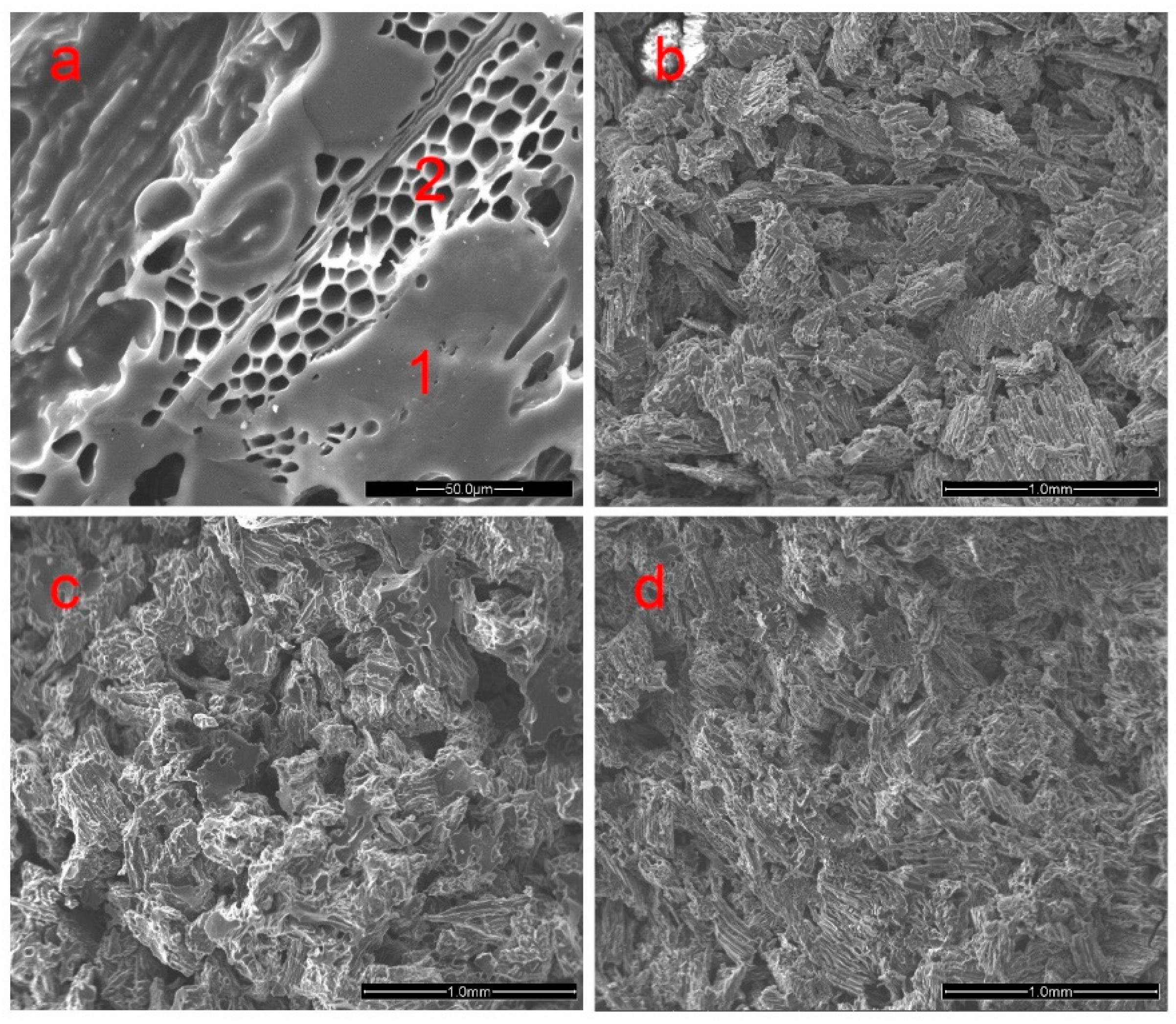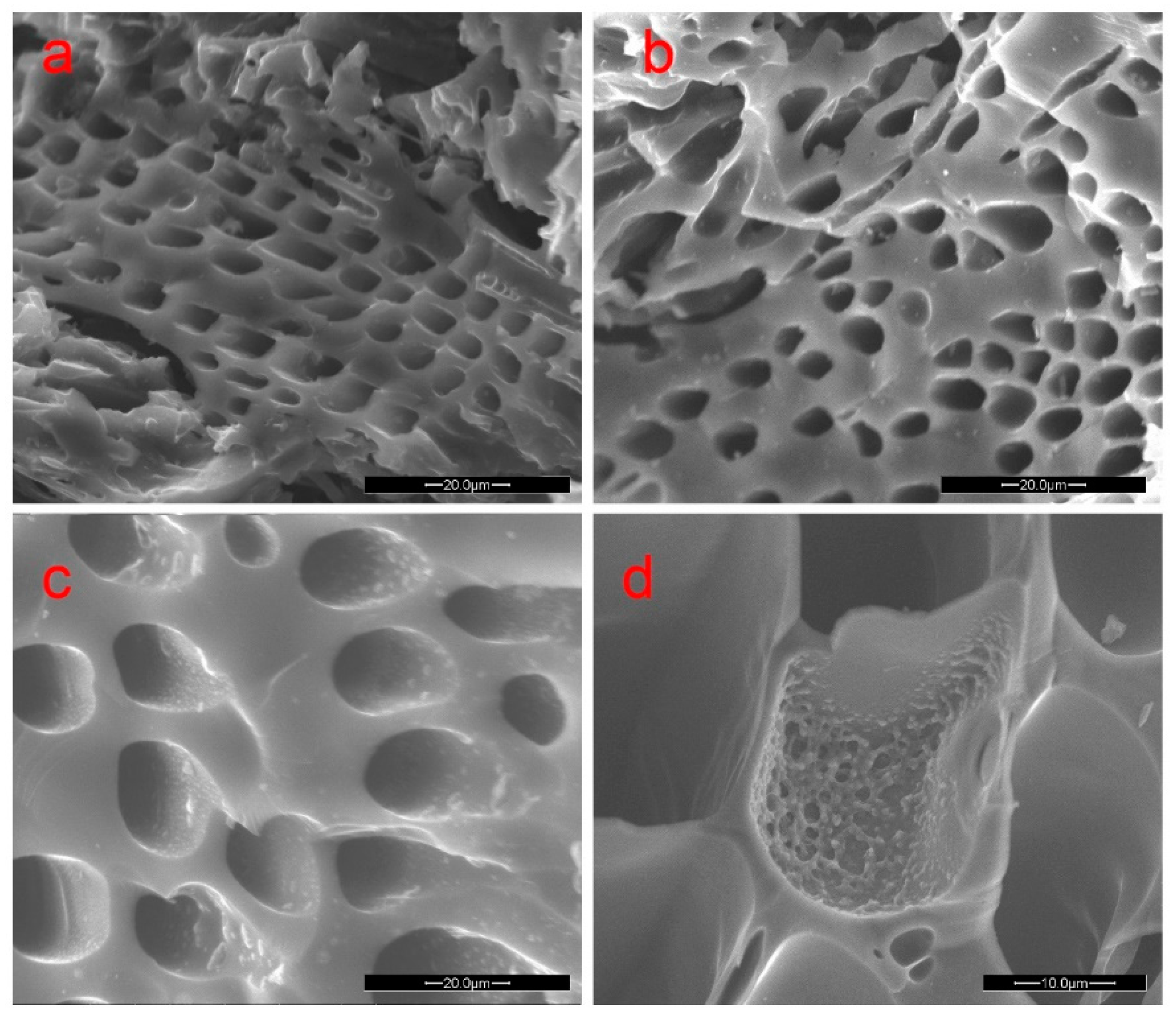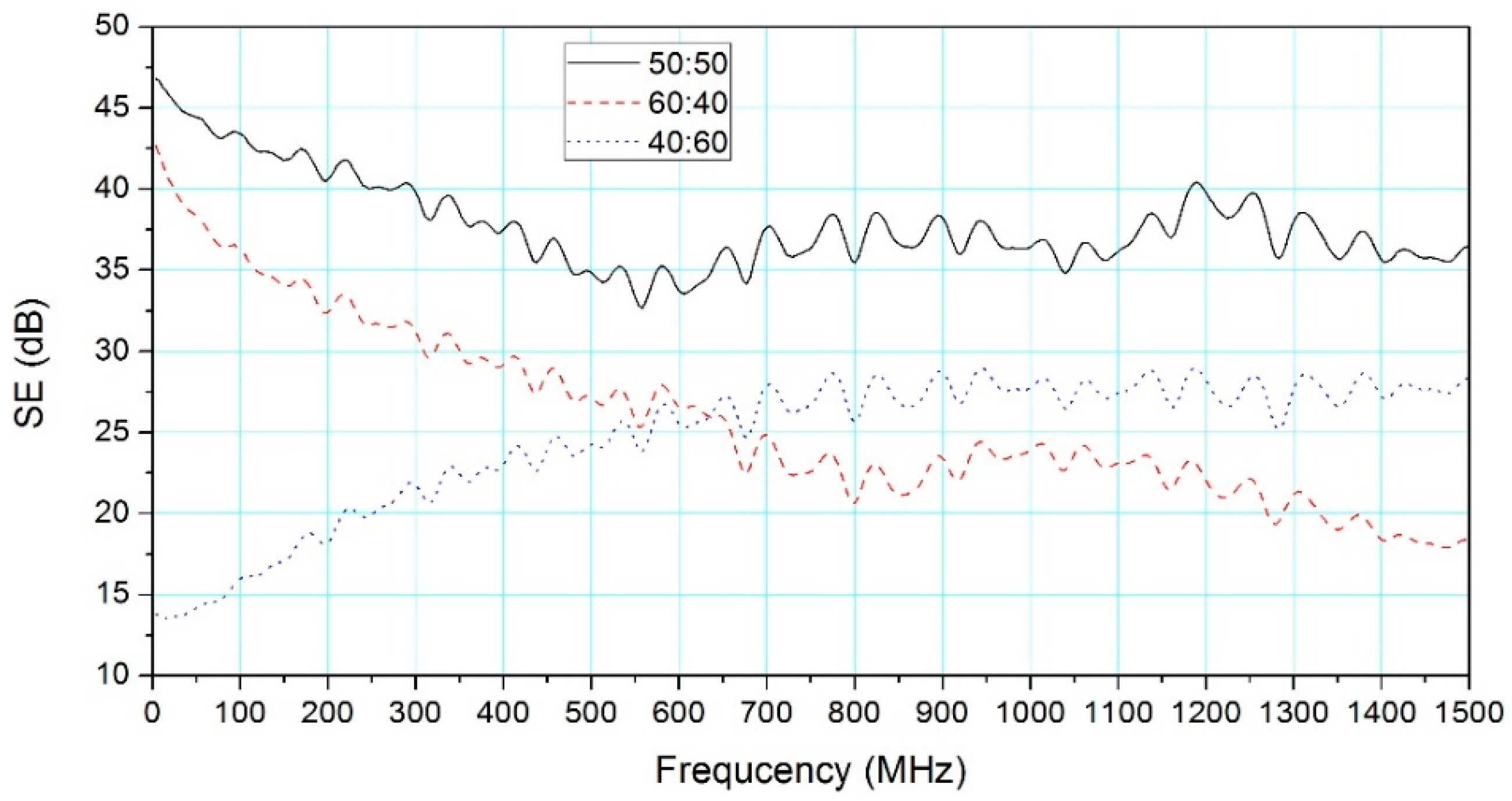Effects of Carbonization Temperature and Component Ratio on Electromagnetic Interference Shielding Effectiveness of Woodceramics
Abstract
:1. Introduction
2. Materials and Methods
2.1. Woodceramics Preparation
2.2. Morphology
2.3. Measurement of EMI SE
3. Results and Discussion
3.1. Morphology
3.2. Effect of Carbonization Temperature on EMI SE
3.3. Effect of Wood/Resin Ratio on EMI SE
4. Conclusions
Acknowledgments
Author Contributions
Conflicts of Interest
References
- Chung, D.D.L. Electromagnetic interference shielding effectiveness of carbon materials. Carbon 2001, 39, 279–285. [Google Scholar] [CrossRef]
- Von Klemperer, C.J.; Maharaj, D. Composite electromagnetic interference shielding materials for aerospace applications. Compos. Struct. 2009, 91, 467–472. [Google Scholar] [CrossRef]
- Yang, S.; Lozano, K.; Lomeli, A.; Foltz, H.D.; Jones, R. Electromagnetic interference shielding effectiveness of carbon nanofiber/LCP composites. Compos. Part A Appl. Sci. Manuf. 2005, 36, 691–697. [Google Scholar] [CrossRef]
- Huang, J. EMI shielding plastics: A review. Adv. Polym. Technol. 1995, 14, 137–150. [Google Scholar] [CrossRef]
- Chen, X.; Liu, L.; Liu, J.; Pan, F. Microstructure, electromagnetic shielding effectiveness and mechanical properties of Mg-Zn-Y-Zr alloys. Mater. Des. 2015, 65, 360–369. [Google Scholar] [CrossRef]
- Al-Saleh, M.H.; Saadeh, W.H.; Sundararaj, U. EMI shielding effectiveness of carbon based nanostructured polymeric materials: A comparative study. Carbon 2013, 60, 146–156. [Google Scholar] [CrossRef]
- Park, D.H.; Lee, Y.K.; Park, S.S.; Lee, C.S.; Kim, S.H.; Kim, W.N. Effects of hybrid fillers on the electrical conductivity and EMI shielding efficiency of polypropylene/conductive filler composites. Macromol. Res. 2013, 21, 905–910. [Google Scholar] [CrossRef]
- Wu, Z.P.; Li, M.M.; Hu, Y.Y.; Li, Y.S.; Wang, Z.X.; Yin, Y.H.; Chen, Y.S.; Zhou, X. Electromagnetic interference shielding of carbon nanotube macrofilms. Scr. Mater. 2011, 64, 809–812. [Google Scholar] [CrossRef]
- Dou, Z.; Wu, G.; Huang, X.; Sun, D.; Jiang, L. Electromagnetic shielding effectiveness of aluminum alloy-fly ash composites. Compos. Part A 2007, 38, 186–191. [Google Scholar] [CrossRef]
- Wen, S.; Chung, D.D.L. Electromagnetic interference shielding reaching 70 dB in steel fiber cement. Cem. Concr. Res. 2004, 34, 329–332. [Google Scholar] [CrossRef]
- Xia, C.; Zhang, S.; Ren, H.; Shi, S.Q.; Zhang, H.; Cai, L.; Li, J. Scalable fabrication of natural-fiber reinforced composites with electromagnetic interference shielding properties by incorporating powdered activated carbon. Materials 2016, 9, 10–19. [Google Scholar] [CrossRef]
- Fan, T.X.; Hirose, T.; Okabe, T.; Zhang, D.; Teranisi, R.; Yoshimura, M. Effect of components upon the surface area of woodceramics. J. Porous Mater. 2002, 9, 35–42. [Google Scholar] [CrossRef]
- Green, D.J.; Colombo, P. Cellular ceramics: Intriguing structures, novel properties and innovative applications. Mater. Res. Soc. Bull. 2003, 4, 296–300. [Google Scholar] [CrossRef]
- Shibata, K.; Okabe, T.; Saito, K.; Okayama, T.; Shimada, M.; Yamamura, A.; Yamamoto, R. Electromagnetic shielding properties of woodceramics made from wastepaper. J. Porous Mater. 1997, 4, 269–275. [Google Scholar] [CrossRef]
- Bantsis, G.; Betsiou, M.; Bourliva, A.; Yioultsis, T.; Sikalidis, C. Synthesis of porous iron oxide ceramics using Greek wooden templates and mill scale waste for EMI applications. Ceram. Int. 2012, 38, 721–729. [Google Scholar] [CrossRef]
- Suda, T.; Kondo, N.; Okabe, T.; Saito, K. Electrical properties of woodceramics. J. Porous Mater. 1999, 6, 255–258. [Google Scholar] [CrossRef]
- Oh, S.-W.; Byeon, H.-S. Far-infrared ray emission and electrical properties of woodceramics manufactured with thinned logs. For. Prod. J. 2006, 56, 29–32. [Google Scholar]
- Li, W.; Zhang, L.; Peng, J.; Li, N.; Zhang, S.; Guo, S. Effects of microwave irradiation on the basic properties of woodceramics made from carbonized tobacco stems impregnated with phenolic resin. Ind. Crop. Prod. 2008, 28, 143–154. [Google Scholar] [CrossRef]
- Zhang, L.; Li, W.; Peng, J.; Li, N.; Pu, J.; Zhang, S.; Guo, S. Raman spectroscopic investigation of the woodceramics derived from carbonized tobacco stems/phenolic resin composite. Mater. Des. 2008, 29, 2066–2071. [Google Scholar] [CrossRef]
- Qian, J.; Jin, Z.; Wang, J. Structure and basic properties of woodceramics made from phenolic-basswood powder composite. Mater. Sci. Eng. A 2004, 368, 71–74. [Google Scholar] [CrossRef]
- Fan, T.X.; Hirose, T.; Okabe, T.; Zhang, D. Surface area characteristics of woodceramics. J. Porous Mater. 2001, 8, 211–217. [Google Scholar] [CrossRef]





© 2016 by the authors; licensee MDPI, Basel, Switzerland. This article is an open access article distributed under the terms and conditions of the Creative Commons Attribution (CC-BY) license (http://creativecommons.org/licenses/by/4.0/).
Share and Cite
Tao, Y.; Li, P.; Shi, S.Q. Effects of Carbonization Temperature and Component Ratio on Electromagnetic Interference Shielding Effectiveness of Woodceramics. Materials 2016, 9, 540. https://doi.org/10.3390/ma9070540
Tao Y, Li P, Shi SQ. Effects of Carbonization Temperature and Component Ratio on Electromagnetic Interference Shielding Effectiveness of Woodceramics. Materials. 2016; 9(7):540. https://doi.org/10.3390/ma9070540
Chicago/Turabian StyleTao, Yubo, Peng Li, and Sheldon Q. Shi. 2016. "Effects of Carbonization Temperature and Component Ratio on Electromagnetic Interference Shielding Effectiveness of Woodceramics" Materials 9, no. 7: 540. https://doi.org/10.3390/ma9070540





